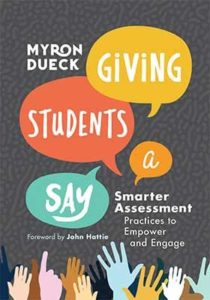Giving Students a Say in Assessing Progress
Giving Students a Say: Smarter Assessment Practices to Empower and Engage
By Myron Dueck
(ASCD, 2021 – Learn more)
Reviewed by Jennifer Wirtz
In Giving Students a Say: Smarter Assessment Practices to Empower and Engage, Myron Dueck details all of the important reasons (backed by research) that students should have a say in assessment practices.
As I read chapter 1, I immediately thought of the rigorous National Boards process I recently completed.
Students, like educators in the NB certification process, are encouraged to monitor their own progress by being able to answer similar questions – Where am I going in my learning (teaching)? Where am I now? How do I improve my learning (about teaching) and that of others? – to name a few. This book makes a compelling argument as to “why” students should be involved in the assessment conversation.

- Sharing and co-creating learning targets;
- Using standards-linked rubrics to provide success criteria;
- Opportunities for student input in ongoing assessments;
- Devising reliable, fair, and sensible grading systems;
- Designing student self-reporting structures.
Planning with learning targets
On pages 18-19 Dueck includes an example unit plan with learning targets. Targets are broken into four categories: knowledge targets, reasoning targets, skill targets, and product targets. Reading this section made clear to me how I could organize my planning more effectively.
Dueck goes on to explain that students can only aim for a target once they understand it exists, giving strategies and ideas for students and teachers to build, share, and use learning targets.
Furthermore, the text spends a good amount of space on the components of rubrics and how we can improve them to achieve a smarter assessment process. I found this section to be thought provoking, and I reflected intensely on how I create and use rubrics in my own classroom.
Reflecting on current practices
Dueck includes “Seven Design Considerations” intended to be discussion starters to reflect upon current practices. I found these to be extremely useful to facilitate a conversation among colleagues in helping to collaboratively determine what exactly we want students to know and do.
After reading this material, I agreed with the author that learning is a process that changes over time and through different situations. After all, if the last two years have taught us anything, it is that we need to adapt, change and/or be flexible in all aspects of education.
Including student voice in assessment
There is a real need for student voice in all aspects of the assessment process. Students should be given the opportunity to self-report their progress, and teachers need to create deliberate space for student voice and meaningful self-evaluation – ultimately finding this common language to make it all matter. This will give students more voice, control, and agency.
Read Myron Dueck’s article for MiddleWeb about smarter assessment
Jennifer Wirtz has been a 6th, 7th and 8th grade English Language Arts teacher at Gemini Middle School in Niles, Illinois for almost two decades. She received a B.A. and a B.S. from Loyola University Chicago and a Masters in Education from DePaul University. She is married to a math teacher and has two young children. See her other MiddleWeb reviews here.






























